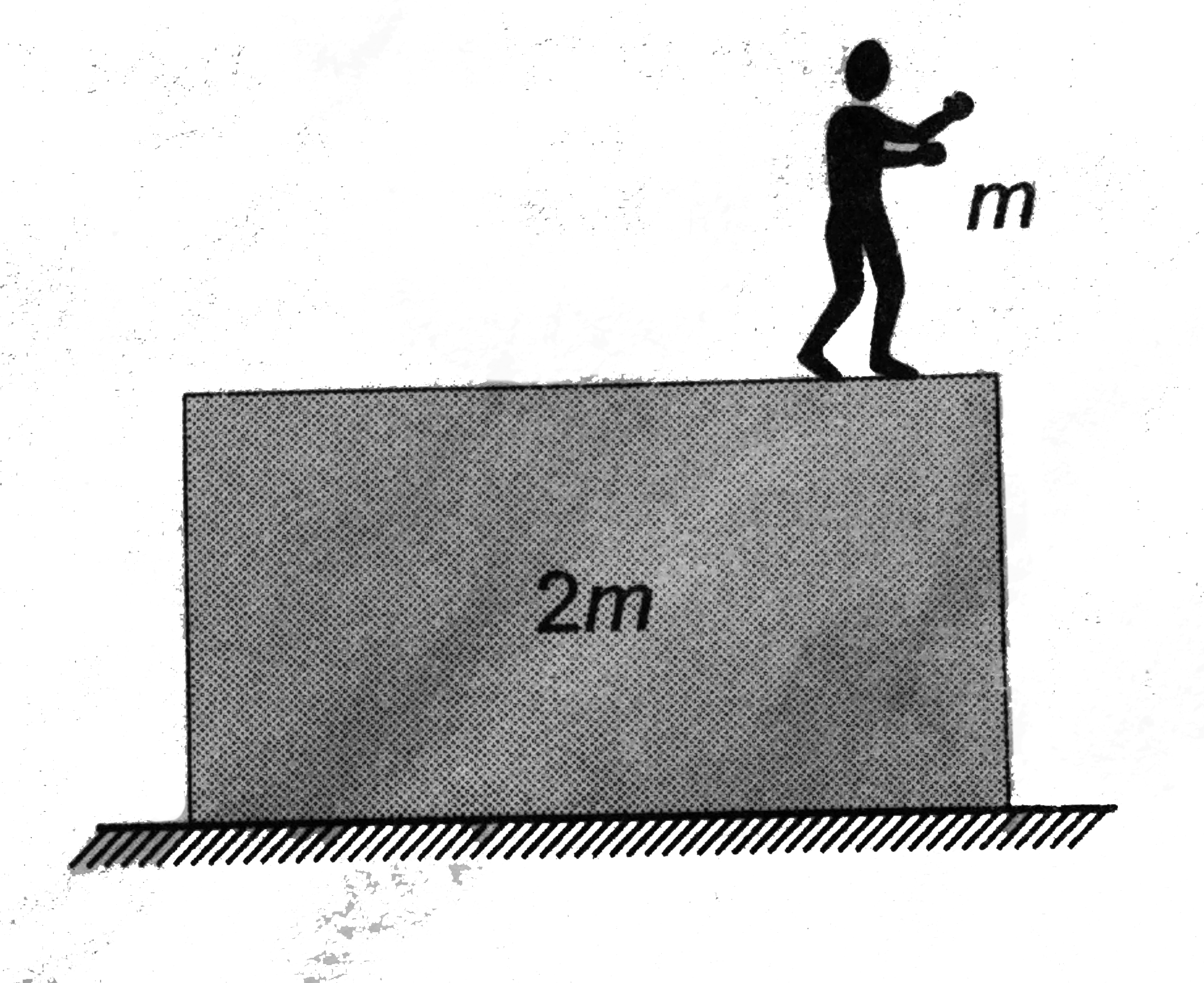Two identical buggies of each of mass 150kg move one after the other friction with same velocity 4ms. A man of mass m rides the rear buggy. At a certain moment, the man jumps into the front buggy with a velocity v relative to his buggy. As a result of this process, real boggy stops. If the sum of kinetic energies of the man and the front buggy just after collision with the from buggy differs from that just before collision by 2700J then
the mass m of the man is
60kg
75kg
50kg
90kg
The correct Answer is:C
Since rear buggy stops and velocity of man relative to this buggy is v, therefore, absolute velocity of man at the jump is v. Applying law of conservation of momentum on the system of rear buggy and man,
mv=(150+m)4……….i
Kinetic energy of man and front buggy (just before collision) is
E1=12mv2+12×150×42
Let velocity of the front buggy, after collision be vc.
Applying law of conservation of momentum on the system of front buggy and man, we get
mv+150×4=(m+150)vc…………ii
Kinetic energy of the system after collision is
E2=12(m+150)v2c………iii.
But E1−E2=2700J
From above three equations vc=7m/s
m=50kg
v=16m/s
Topper's Solved these Questions
- CENTRE OF MASSBOOK - CENGAGE PHYSICSCHAPTER - CENTRE OF MASSEXERCISE - Integer
16 Videos
- CENTRE OF MASSBOOK - CENGAGE PHYSICSCHAPTER - CENTRE OF MASSEXERCISE - Fill In The Blanks
2 Videos
- CENTRE OF MASSBOOK - CENGAGE PHYSICSCHAPTER - CENTRE OF MASSEXERCISE - Assertion - Reasoning
2 Videos
- CALORIMETRYBOOK - CENGAGE PHYSICSCHAPTER - CALORIMETRYEXERCISE - Solved Example
13 Videos
- DIMENSIONS & MEASUREMENTBOOK - CENGAGE PHYSICSCHAPTER - DIMENSIONS & MEASUREMENTEXERCISE - Integer
2 Videos
Similar Questions
Two identical buggies move one after the other due to inertia (without friction) with the same velocity v0. A man of mass m rides the rear buggy. At a certain moment the man jumps into the front buggy with a velocity u relative to his buggy. Knowing that the mass of each buggy is equal to M, find the velocities with which the buggies will move after that.
View SolutionA buggy of mass 100 kg is free to move on a frictionless horizontal track. Two men, each of mass 50 kg, are standing on the buggy, which is initially stationary. The men jump off the buggy with velocity =10m/s relative to the buggy. In one situation, the men jump one after the other. in another situation, the men jump simultaneously. what is the ratio of the velocities of the buggy in two cases?
View Solution
Knowledge Check
Two identical buggies of each of mass 150kg move one after the other friction with same velocity 4m/s. A man of mass m rides the rear buggy. At a certain moment, the man jumps into the front buggy with a velocity v relative to his buggy. As a result of this process, real boggy stops. If the sum of kinetic energies of the man and the front buggy just after collision with the from buggy differs from that just before collision by 2700J then
The velocity v of the man relartive to the buggy isA16m/sB8m/sC10m/sD15m/sTwo identical particles move towards each other with velocity 2v and v respectively. The velocity of centre of mass is
AVBV/3CV/2DZeroTwo identical particles move towards each other with velocity 2v and v, respectively. The velocity of the centre of mass is:
AvBv/3Cv/2Dzero
what is the momentum of a man of mass 75kg when he walks with a velocity of 2m/s?
View SolutionA boat of mass 1000 kg is moving with a velocity of 5 m/s. A person of mass 60 kg jumps into the boat. The velocity of the boat with the person will be -
View SolutionA man is standing on a cart of mass double the mass of man. Initially cart is at rest. Now, man jumps horizontally with velocity u relative to cart. Then work done by man during the process of jumping will be

View SolutionA wagon of 200kg is moving on a smooth track with velocity of 2m/sec. A man of 80kg also runs in the wagon with a velocity such that speed of the centre of mass of the system is zero. Find the velocity of man relative to the wagon (in m//s).
View SolutionTwo identical particles move towards each other with velocity 2v and v respectively. The velocity of centre of mass is
View Solution
